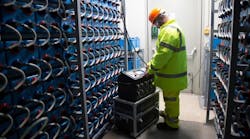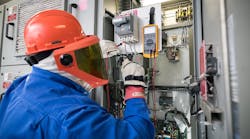Insulation resistance testers measure the following three quantities:
- Absorption current starts high and then drops. At the same time, voltage starts low and rises. What you're measuring is the rate of storage (absorption) of potential energy in and on insulation. Understanding this process is important to understanding the time resistance method of insulation testing.
- Capacitive current is the initial surge of current that occurs when you apply voltage to a conductor. The conductor acts like a capacitor in that it "charges up." As with absorption current, capacitive current starts high and then drops.
- Leakage current, also called "conduction current," is the steady flow of current through and on the insulation. If you graph this on a time trend, you should notice a gradual sloping of the line. When that slope suddenly changes, the insulation is undergoing accelerated deterioration.


